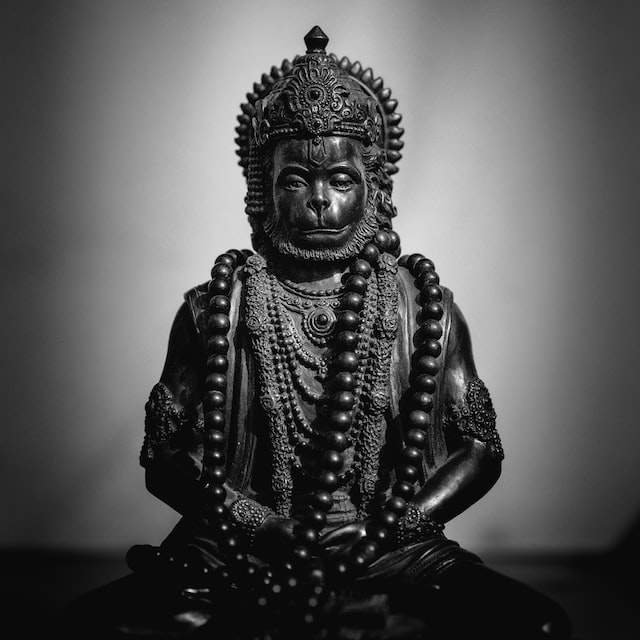To wit: Hanuman, a legendary warrior with an important part in the Ramayana epic.

The god of fire, Agni, granted him protection from flames. The sun deity Surya granted him the ability to enlarge or diminish his physical form. Yama bestowed to him the gifts of eternal youth and perfect health. The celestial architect Vishwakarma granted him the gift that he would be immune to harm from everything he had made. Words like “invincible” and “immortal” are frequently used to describe him. The name for him is Hanuman. One of Hinduism’s numerous gods is the monkey god Hanuman. He is widely recognized as the supreme leader of the fictional monkey nation of Kiskindha. Among Hindus, Hanuman is best known for his support of Rama and his brother Laksmana in the Ramayana [The Ramayana is a Sanskrit epic revolving around the characters of Rama, Sita, Hanuman, and Laksmana]. Rama is the protagonist of the story, and Laksmana is Rama’s brother who follows him into exile.
Hanuman, according to the Ramayana, was so loyal to Rama that he volunteered to travel to Lanka [many people believe Lanka to be the location of today’s Sri Lanka] in order to find Sita. Since Rama was exiled from the city for a total of 14 years, he is unable to make the trip there himself. Previously in the Ramayana, Rama had declared that “anywhere, even among the animals, can be found virtuous creatures that follow the paths of righteousness, that are brave and provide a sure place of shelter”. Hanuman is a devoted and noble person who is willing to take the risk of entering Ravana’s territory to save Sita, therefore this description fits him perfectly. Although Hanuman eventually locates Sita, the devoted wife ultimately declines to accompany him home. Since she considers it Rama’s dharma to rescue her on his own, she refuses to get into contact with any other male.
In the Ramayana epics, Hanuman also exhibits a few significant powers that serve him well in his job. Hanuman is a significant player in the Sundarakanda [the fifth book of the Ramayana] and is known for his incredible leaps of distance. His leap from Mahendra to Trikuta in Sri Lanka is proof of this. This cross-country jump and subsequent quest for Sita highlight his dual nature as a monkey-hero. The fact that “almost two hundred verses are devoted to the description of his jump” shows how pivotal Hanuman is to the plot, as the poet says. When Hanuman makes his famous leap to Lanka, “he takes on a size that is considered to be immeasurable,” further illustrating his extraordinary abilities. It has been stated that as he soars above the ocean, his shadow spans a distance of ten leagues across and thirty leagues in length.
Hanuman exhibits the variability of his emotional states. “In the first half of the Sundarakanda, Hanuman’s huge and rapid shifts in stature are mirrored by his sharp swings in emotion,” says the poet Kalidasa. Despite his initial zeal and excitement, Hanuman “lapses into melancholy contemplation” when he encounters obstacles on his way to Lanka. When Hanuman learns that Sita is safe, he intends to wreak havoc in Lanka. Ravana orders his troops to capture Hanuman, but no one can keep the monkey under control. With no other option, Ravana sends out his son, the mighty warrior Indrajit, who quickly discovers that he, too, is powerless to slay Hanuman. He was able to acquire the “divine sword of the god Brahma,” which slowed down Hanuman’s destructive rampage. Although it is never stated explicitly in the Ramayana that Hanuman was immortal, “Both tales of his birth, one in the Kiskindhakanda and one in the Uttarakanda,” suggest that Hanuman’s life expectancy will be significantly longer than average. According to Jambavan, Indra granted him the privilege of determining his own time of death in the former. Brahma predicts his extended life span in the second version.
Indrajit, while being a powerful fighter, may have come to the conclusion that he will never be able to kill Hanuman if it is true that Hanuman may choose when he will die. This shows that Hanuman is unique among monkeys, despite sharing their rashness and spontaneity. His abilities, his character, and the fact that he was the first to locate Sita all point to him being divine. Goldman claims that Hanuman has a “dual nature” in this depiction. Even though he’s shown as a monkey with monkey impulses, he’s also portrayed as a hero because of how frequently he tries to rescue others. His constant growth and shrinking highlights this duality. As a manifestation of his divine/heroic nature, he has the ability to take on a monstrous form. Perhaps he can reduce his size down below that of a normal person.
Hanuman’s demeanor and abilities are a direct product of his birth family. He is the son of Vayu (the god of the wind) and Anjana (the goddess of knowledge). His ancestry supposedly grants him the ability to travel at the speed of light. It is mentioned in the Sundarakanda that his father assists him in his quest to find Sita by having him go back and forth between the two realms.
Although the Ramayana is where Hanuman first became well-known, it is far from the only epic in which he appears. Hanuman and his half-brother Bhima, both sons of the wind god Vayu, meet in the Kadali Forest during the events of the Mahabharata. When Bhima was on his way, he came across Hanuman dozing over the road. So that Bhima could pass, he asked Hanuman to make room for him. In response, Hanuman requested that Bhima swivel his tail to one side. Not even Bhima, the strongest of the Pandava brothers, was able to move Hanuman’s tail. After arriving in Lanka, Hanuman introduced himself to Bhima in the disguise he had used to get there. To See the real significance of lord hanuman you can visit many temples in India. Which is only dedicated to hanuman. One of them is Jakhu temple shimla ,in Himachal Pradesh, India.
“his representations are coated with the sacred color vermilion, to symbolize the regard in which he is held, and the general appreciation of his devotion as a model faithful servant,” says one account of the widespread devotion to the Hindu god Hanuman in India. His dedication to Rama earned him respect and admiration. He ignored his own safety in order to risk everything to save Sita, a woman he had never seen or spoken to before. The Sri Hanuman Maharaj temple, also known as the Big Lord Hanuman temple, is a white marble structure located in Delhi. Many Hindus believe that Hanuman’s notoriety has been growing throughout the years, much like the size of his body in the stories about him. Larger and more elaborate murtis of the big monkey have been erected in prominent locales, demonstrating the increasing popularity of this image. “He [Hanuman] is the embodiment of sakti and bhakti,” or, in a nutshell, power and devotion. Because of this, he has a great deal of respect and popularity.
Despite his unconventional upbringing, Hanuman enjoys widespread renown. Many people enjoy Hanuman’s early life narratives because of the relatable characters and situations. As a little child, he reaches towards the “rising sun” in the hope of touching it. Hanuman’s name comes from the Sanskrit word for jaw, which was broken when he fell; the god Indra saw this as a danger and sent him crashing back down. Later, Vayu, Hanuman’s dad, threatens the entire universe. Each god offers Hanuman a special gift as penance for what occurred to him in his youth, endowing him with abilities that will serve him well in his later exploits. When it comes to the Ramayana and other stories where Hanuman appears, he plays a pivotal part. Among the Hindu community and beyond, his fame is immense. Hanuman is a great person to look up to because of his unwavering devotion.







